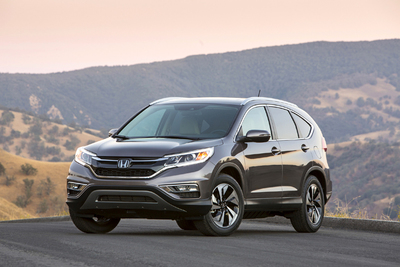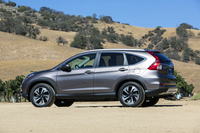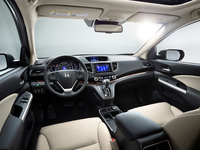2016 Honda CR-V Touring AWD Review by Carey Russ +VIDEO
 |
A right-sized, comfortable, economical, useful, and versatile crossover...just better than ever.
DRIVING DOWN THE ROAD WITH CAREY RUSS
• SEE ALSO: Honda Research and Buyers Guide
 |
The CR-V gave Honda a presence in the compact crossover class in the late 1990s, when truck-based SUVs still ruled. Based on the Civic, it had the looks of a small truck and the comforts and ride quality of a Civic. No surprise that it was a hit then, or that its success has continued. There's a useful amount of room inside of a small exterior package, so not only can it hold people and their stuff in comfort, it's easy to park. It's not too tall or high off the ground, so access is good. It has a minimal thirst for unleaded regular, and is comfortable and car-like on the road.
The latest generation of CR-V, the fourth, debuted for model year 2012. It got a "mid-product cycle freshening" for 2015. That usually means a minor restyling, new colors and options, and similar relatively minor changes. Not in this case. There was the expected minor restyle, changes to standard and optional features, a new premium Touring trim level… and an all-new engine and transmission.
The new engine had the same 2.4-liter capacity and made the same 185 peak horsepower. But that peak was at lower revs, 6400 vs. 7000, and more importantly torque was up by 11 percent from 163 to 181 lb-ft. The torque peak has dropped from 4400 rpm to 3900, and more torque was available pretty much everywhere. Direct fuel injection allowed higher compression for better efficiency -- meaning both increased power production and decreased fuel use. The previous five-speed automatic gave way to a wide-ratio continuously-variable transmission (CVT) for further improvements in efficiency. Powertrain weight has decreased, further helping fuel efficiency.
Changes for 2016 are… none. Honda has been busy with the new Civic, so no surprise. As before, trim levels are the well-equipped LX, upgraded EX, semi-luxury EX-L (for leather, among other additions), and premium Touring. All are offered in front- or all-wheel drive (AWD) form. Like all current Hondas, all have a backup camera. The LX is hardly a must-add-extras "base model" and has pretty much everything you actually need in a car, and more. EX means alloy wheels, upgraded audio, heated front seats, the LaneWatch™ passenger-side rear quarter camera, pushbutton start/stop, and more. EX-L adds leather, further audio upgrades, dual-zone climate control, and roof rails. EX-L With Navi adds touchscreen-based voice-activated navigation. Touring builds on that with features once only found in luxury brands, including adaptive cruise control, forward collision warning, collision-mitigation braking, lane-departure warning, and the Lane Keeping Assist System. It adds a 10-way power-adjustable driver's seat with two-position memory, a power tailgate, projector-beam headlights, and 18-inch alloy wheels as well.
And that, in AWD form, has been my test car for the past week. "Fully-equipped" barely does it justice. But all of the upscale amenities are hardly necessary to recognize the functional goodness that defines the CR-V. It's a convenient size, neither too small to hold enough nor too large to navigate crowded parking spaces and traffic. The additional torque and wider ratio range of the new CVT mean that performance is more than merely adequate, and with a 1500-pound towing capacity a small trailer for camping, boat, motorcycles, personal watercraft, and such is easily dealt with. Honda may call it an SUV, but the CR-V is really a tall car at heart, and for everyday use that's a much better deal. It embodies the phrase "moderation in all things" and there's nothing wrong with that.
APPEARANCE: Evolution, not revolution. It started as a boxy mini-SUV, but over the years the CR-V has become increasingly less of the box it came in. There is continuity in design evolution. especially at the front and on the sides, from the 2006 third generation through today as the grille and headlights have become increasingly bolder and more integrated in the manner of other current Hondas. Changes for 2015 were to details, with no further changes this year. Vertical taillights have been a CR-V hallmark since the beginning, and continue. The newest CR-V looks larger than any previous version, but the wheelbase is unchanged and exterior dimensions have changed only by a couple of inches or less since its very beginning. The Touring gets projector-beam headlights and LED running lights.
 |
COMFORT: Inside the Touring are most all of the accoutrements of an entry-luxury crossover, but I don't think that even a lowly LX offers less in the way of real, practical comfort and convenience. Here you get good leather seating, with a high-eyepoint driving position for forward visibility. Controls and instruments are positioned for ease of use, extending to the touchscreen-based navigation, audio, phone, and information system controls -- although the small hard button controls surrounding the screen are on the small side. The dual-zone climate control system works by means of simple knobs and buttons. Interior materials are first-rate for the class, with dark, textured soft-touch upper surfaces and chrome and faux-aluminum trim. All trim levels have a center console with configurable partitions and rear-seat HVAC ducts. The outboard rear seat contouring is deep enough for comfort but flat enough to make the center position better than average. A flat floor help, too. The rear seat is split 60/40, and each section not only has a folding seatback, cushions can flip up, too -- without need to remove the headrests. There is plenty of space in the cargo area without recourse to that, and a shade keeps items there out of view. A space-saver spare tire is found under the cargo area floor.
SAFETY: Multiple changes have been made to the CR-V's unibody structure for improved crash energy absorption, improved sound insulation, and increased rigidity for more precise suspension operation and decreased noise, vibration, and harshness (NVH). Honda calls their structural deformation-management engineering Advanced Compatibility Engineering™ (ACE™ for short). All mandated and expected safety equipment is found in all models. The Touring has electronic systems including adaptive cruise control, forward collision warning, collision-mitigation braking, lane-departure warning, and the Lane Keeping Assist System as standard equipment.
RIDE AND HANDLING: It's basically a tall wagon, but good design and engineering hides the CR-V's height when it comes to responsive handling and the increased structural rigidity allows the fully-independent MacPherson strut / multilink suspension to do its job comfortably and efficiently. "Moderate" is the word. Ride quality is smooth and comfortable, and the electrically-assisted steering is neither too light nor too stiff. Four-wheel disc brakes do their job well, and AWD examples have slightly larger discs.
PERFORMANCE: If there is no increase in horsepower, why change the engine? Maximum horsepower is good for marketing/advertising/bragging -- but very rarely used in everyday driving. Here, torque is what counts. Although displacing the same 2.4 liters as the previous engine, and having the same basic 16-valve, dual overhead cam design, everything inside is new and most components are lighter. Most notably, direct fuel injection is used, which allows a higher compression ratio, which increases efficiency -- more power and lower emissions. And more torque over a wider rev range. i-VTEC valve control varies intake cam phasing and both intake and exhaust lift, timing, and duration for an optimum combination of power and efficiency. Maximum horsepower is unchanged, at 185 -- but it's at a lower engine speed, 6400 rpm. Torque increases from 163 to 181 lb-ft, also at lower revs so more useful. Use of a CVT, with a 33 percent wider ratio range than the previous five-speed automatic, further helps efficiency. Since there are no discrete gear changes, it's very smooth. Acceleration is a bit quicker than before, a quarter- to a half-second 0-60, and there are improvements in fuel economy as well. EPA estimates are 26 mpg city, 33 highway. I got a 26mpg average during my week, with mostly city and backroad driving. A gentler right foot and more highway miles could easily improve that.
CONCLUSIONS: The Honda CR-V is what it always has been -- a right-sized, comfortable, economical, useful, and versatile crossover. It's just better at everything than ever.
SPECIFICATIONS
2015 Honda CR-V Touring AWD
Base Price $ 33,395
Price As Tested $ 34,295
Engine Type 16-valve DOHC aluminum alloy 4-cylinder with direct fuel injection and i-VTEC variable valve lift and timing
Engine Size 2.4 liters / 144 cu. in.
Horsepower 185 @ 6400 rpm
Torque (lb-ft) 181 @ 3900 rpm
Transmission CVT
Wheelbase / Length 103.1 in. / 179.4 in.
Curb Weight 3624 lbs.
Pounds Per Horsepower 19.6
Fuel Capacity 15.3 gal.
Fuel Requirement 87 octane unleaded regular gasoline
Tires P225/60R18 99H Dunlop Grand Trek m+s
Brakes, front/rear vented disc / solid disc, ABS, EBD, BA, VSA standard
Suspension, front/rear independent MacPherson strut / independent multi-link
Drivetrain transverse front engine, on-demand all-wheel drive
PERFORMANCE
EPA Fuel Economy - miles per gallon city / highway / observed 26 / 33 / 26
0 to 60 mph 8.3 sec
Towing Capacity 1500 lbs.
OPTIONS AND CHARGES
Destination Charge $ 900


